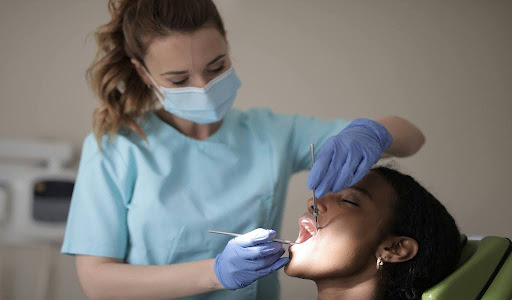Tirzepatide for Sleep Apnea - Can It Help?
Understanding Sleep Apnea and Its ChallengesSleep apnea is a common yet serious sleep disorder characterized by repeated interruptions in breathing during sleep. These pauses [...]
Read More
Medically reviewed by Abhijit Bhattacharyya | MD, PhD, MBA, Tufts University School of Medicine - Miami, Florida on June 20th, 2025.
A tooth infection, also known as a dental abscess, can be a painful and distressing condition. It occurs when bacteria invade the inner pulp of the tooth, leading to inflammation, pus formation, and sometimes severe discomfort. Understanding the implications of leaving a tooth infection untreated is crucial for maintaining overall dental health. This article explores the risks associated with untreated tooth infections, the signs to look for, and the importance of seeking timely treatment.
 Understanding Tooth Infections
Understanding Tooth InfectionsTooth infections can arise from various sources, including untreated cavities, gum disease, or trauma to the tooth. When bacteria penetrate the tooth's protective layers, they can multiply and cause an infection in the pulp, leading to a range of symptoms. If left untreated, these infections can spread to surrounding tissues and even lead to more severe health complications, emphasizing the importance of prompt dental care. For quick guidance and support, telehealth platforms like Doctronic.ai offer access to AI-powered consultations and licensed providers who can help assess symptoms and recommend next steps, especially when in-person care isn’t immediately available.
There are primarily two types of tooth infections: periapical abscess and periodontal abscess. Each type has distinct characteristics and implications for treatment. Understanding these differences is crucial for effective management and prevention of further complications.
Periapical Abscess: This type occurs at the tip of the tooth root and is often a result of untreated cavities or trauma. The infection can lead to significant pain and may require procedures such as root canal therapy to remove the infected pulp and save the tooth.
Periodontal Abscess: This infection occurs in the gums and is typically associated with gum disease. It can lead to the destruction of the supporting structures of the tooth, which may necessitate more extensive treatment, including deep cleaning or surgical intervention.
Identifying a tooth infection early can significantly impact treatment outcomes. Common symptoms include:
Severe toothache that may radiate to the jaw, neck, or ear.
Swelling and redness in the gums.
Pus or a bad taste in the mouth.
Fever and general malaise.
In addition to these symptoms, patients may also experience increased sensitivity to hot or cold temperatures, which can further complicate daily activities like eating or drinking. The discomfort from a tooth infection can be debilitating, often interfering with sleep and overall quality of life. It is essential for individuals experiencing these symptoms to seek dental evaluation as soon as possible, as timely intervention can prevent the infection from worsening and potentially affecting other areas of the body.
Moreover, the risk factors for developing tooth infections extend beyond poor oral hygiene. Conditions such as diabetes, which can impair the body's ability to fight infections, and habits like smoking, which can hinder healing, can also contribute to the likelihood of developing these infections. Regular dental check-ups and maintaining good oral hygiene practices, including brushing and flossing, are vital in reducing the risk of tooth infections and promoting overall dental health.
Untreated tooth infections can lead to serious health complications. The bacteria can spread beyond the tooth and gums, resulting in systemic issues.
When a tooth infection is ignored, it can lead to several local complications:
Bone Loss: The infection can erode the bone surrounding the tooth, leading to tooth mobility and potential loss.
Spread of Infection: The infection may spread to adjacent teeth or tissues, resulting in more extensive dental problems.
Additionally, untreated infections can cause the formation of abscesses, which are painful collections of pus that can develop in the gums or jawbone. These abscesses can create significant discomfort and may require surgical intervention to drain the pus and alleviate pressure.
Furthermore, the presence of an abscess can lead to swelling in the face or neck, which can be alarming and may necessitate immediate medical attention.
In some cases, untreated tooth infections can lead to serious systemic complications, including:
Sepsis: A severe and potentially life-threatening condition that occurs when the body's response to infection causes widespread inflammation.
Heart Issues: Bacteria from dental infections can enter the bloodstream, potentially leading to endocarditis, an infection of the heart lining.
Moreover, chronic infections can also exacerbate pre-existing health conditions such as diabetes, as ongoing inflammation can compromise the body's ability to manage blood sugar levels. This interplay between oral health and systemic health underscores the importance of maintaining regular dental check-ups and addressing any signs of infection promptly. Ignoring dental health can have far-reaching consequences, not just for your mouth but for your overall well-being as well.
The duration one can safely leave a tooth infection untreated varies significantly based on individual circumstances. However, it is generally inadvisable to wait long.
As soon as symptoms of a tooth infection arise, it is crucial to seek dental care. Waiting even a few days can exacerbate the condition and lead to more severe complications. Early intervention not only alleviates pain but also prevents the infection from spreading to surrounding tissues, which can lead to more serious health issues, such as abscess formation or systemic infections.
Several factors can influence how long a tooth infection can be left untreated:
Severity of Symptoms: The more severe the symptoms, the more urgent the need for treatment.
Overall Health: Individuals with compromised immune systems may face higher risks and should seek treatment immediately.
Location of Infection: Infections located deeper in the jaw may spread more quickly than those confined to the gums.
In addition to these factors, the type of bacteria involved in the infection can also significantly influence the urgency of treatment. Some bacteria are more aggressive and can lead to rapid deterioration of dental health, while others may result in a slower progression.
Furthermore, personal pain tolerance varies widely; what may be a minor annoyance for one person could be unbearable for another, thus influencing their decision on when to seek help. It's essential to listen to your body and recognize that persistent discomfort is a signal that should not be ignored.
Moreover, the potential for complications extends beyond the mouth. An untreated tooth infection can lead to serious systemic issues, such as sepsis, which is a life-threatening response to infection. This highlights the importance of not only addressing the local symptoms but also understanding the broader implications of dental health on overall well-being. Regular dental check-ups can help catch issues before they escalate, making it easier to manage oral health proactively.
Upon visiting a dentist, a thorough examination will be conducted to diagnose the infection accurately. This may involve X-rays to assess the extent of the infection.
Diagnosing a tooth infection typically involves:
Clinical Examination: The dentist will check for signs of infection, such as swelling or pus.
X-rays: These help visualize the extent of the infection and any associated bone loss.
Treatment for a tooth infection may vary based on its severity and location. Common options include:
Antibiotics: Prescribed to help eliminate the bacterial infection.
Root Canal Therapy: Involves removing the infected pulp and sealing the tooth to prevent further infection.
Extraction: In cases where the tooth is severely damaged, extraction may be necessary.
In addition to these standard treatments, dentists may also recommend adjunct therapies to enhance recovery and alleviate discomfort. For instance, over-the-counter pain relievers can be suggested to manage pain during the healing process, while warm saltwater rinses may help reduce inflammation and promote oral hygiene.
Furthermore, some dentists may explore the option of using medicated pastes or gels that can be applied directly to the affected area to provide localized relief and combat infection more effectively.
It's also important to note that after treatment, follow-up appointments are crucial to ensure that the infection has been fully resolved and that the tooth is healing properly. During these visits, the dentist will monitor the healing process and may conduct additional X-rays if necessary. Patients are encouraged to maintain good oral hygiene practices, including regular brushing and flossing, to prevent future infections and promote overall dental health.
Additionally, lifestyle factors such as diet and smoking cessation can significantly impact recovery and should be considered as part of a comprehensive treatment plan.
 Prevention is always better than a cure. Maintaining good oral hygiene can significantly reduce the risk of developing tooth infections. Regularly practicing effective oral care not only helps in avoiding infections but also contributes to overall health and well-being.
Prevention is always better than a cure. Maintaining good oral hygiene can significantly reduce the risk of developing tooth infections. Regularly practicing effective oral care not only helps in avoiding infections but also contributes to overall health and well-being.
To prevent tooth infections, consider the following practices:
Brush teeth at least twice a day with fluoride toothpaste.
Floss daily to remove plaque and food particles between teeth.
Regular dental check-ups for professional cleaning and early detection of issues.
In addition to these fundamental practices, using an antibacterial mouthwash can further enhance your oral hygiene routine. This can help reduce the bacteria in your mouth, which is essential for preventing gum disease and tooth decay.
Furthermore, consider using a soft-bristled toothbrush and replacing it every three to four months to ensure effective cleaning without damaging your gums.
A balanced diet plays a crucial role in oral health. Limit sugary snacks and beverages, as they can contribute to tooth decay. Instead, focus on:
Fruits and vegetables that promote healthy gums.
Dairy products provide calcium for strong teeth.
Incorporating foods rich in vitamins and minerals, such as nuts and seeds, can also be beneficial. These foods not only provide essential nutrients but also help in the natural cleaning of teeth as you chew.
Additionally, staying hydrated with water, particularly fluoridated water, can aid in washing away food particles and bacteria, further protecting your teeth from infections.
 In some situations, a tooth infection may require immediate attention. Recognizing these signs can be critical for preventing complications. Ignoring the symptoms of a tooth infection can lead to more serious health issues, including the spread of infection to other parts of the body, such as the jaw, neck, or even systemic circulation. This is why being vigilant about oral health and understanding when to seek emergency care is essential.
In some situations, a tooth infection may require immediate attention. Recognizing these signs can be critical for preventing complications. Ignoring the symptoms of a tooth infection can lead to more serious health issues, including the spread of infection to other parts of the body, such as the jaw, neck, or even systemic circulation. This is why being vigilant about oral health and understanding when to seek emergency care is essential.
Seek emergency dental care if you experience:
Severe swelling that affects your ability to breathe or swallow.
Fever accompanied by chills indicates a potential systemic infection.
Severe pain that is not manageable with over-the-counter pain relief.
Additionally, if you notice a persistent bad taste in your mouth or foul-smelling breath that does not improve with oral hygiene, these can also be signs of a serious infection. Other warning signs may include difficulty opening your mouth or a noticeable lump on your gums. It’s important to take these symptoms seriously, as they can indicate that the infection is worsening and may require urgent intervention.
Emergency treatment may include:
Drainage of the abscess to relieve pressure and pain.
Immediate antibiotics to control the infection.
In some cases, a dentist may also recommend a root canal procedure to remove the infected pulp from the tooth and prevent further complications. This procedure not only alleviates pain but also helps to save the tooth from extraction. Depending on the severity of the infection, follow-up appointments may be necessary to ensure that the infection has been fully resolved and to monitor for any potential recurrence. It is crucial to adhere to the prescribed treatment plan and attend all follow-up visits to maintain optimal oral health.
Leaving a tooth infection untreated can lead to serious health complications, both locally and systemically. It is essential to recognize the symptoms early and seek prompt dental care to avoid further complications. By maintaining good oral hygiene and being aware of the signs of infection, individuals can significantly reduce their risk of developing tooth infections. Prioritizing dental health is not just about preserving teeth; it is about ensuring overall well-being.
Don’t let a tooth infection go untreated—it’s more than just a dental issue! Ignoring it can lead to serious health risks, such as abscesses, bone damage, or even systemic infections. Check out Doctronic today and protect your smile!
Understanding Sleep Apnea and Its ChallengesSleep apnea is a common yet serious sleep disorder characterized by repeated interruptions in breathing during sleep. These pauses [...]
Read MoreHeart attacks are often perceived as a predominantly male health issue, but the reality is that heart disease is the leading cause of death for women worldwide. Recognizing [...]
Read MoreTelehealth has transformed the way patients access healthcare, offering convenience, speed, and accessibility that traditional in-person visits often cannot match. With the [...]
Read More